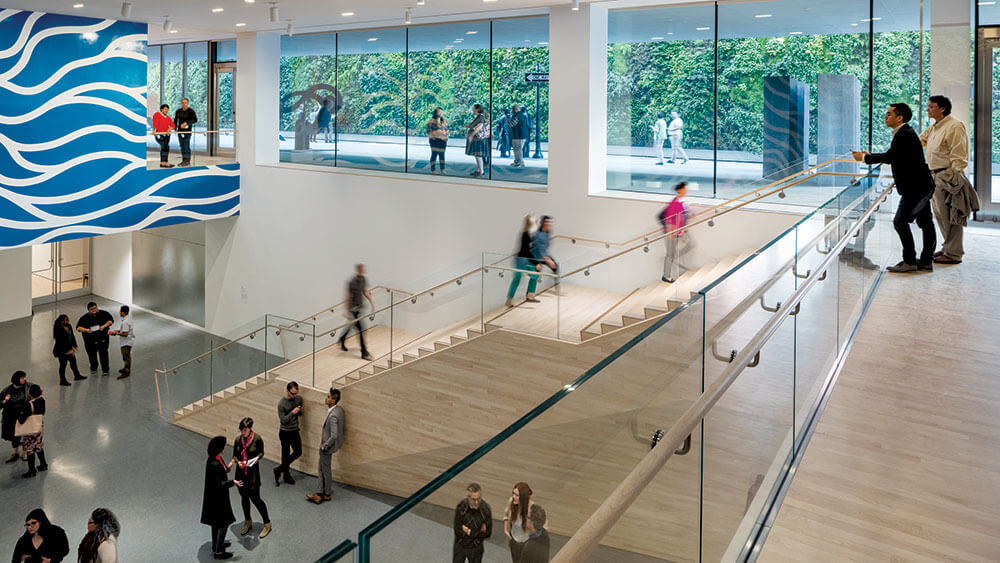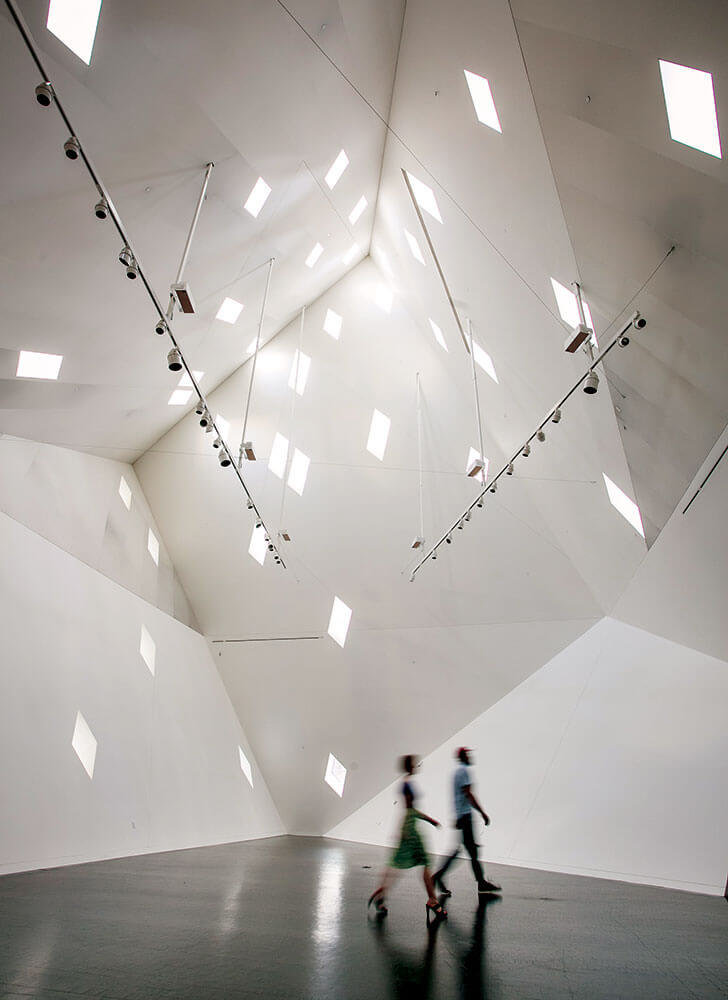
The LED-light sculpture “Point Cloud,” designed by Leo Villarreal, spans the new Moscone Center pedestrian bridge in San Francisco.
I was hosted by the San Francisco Travel Association in late January, along with other meetings industry journalists, to take a look at the recently unveiled $551-million expansion and reinvention of the Moscone Center.
But first we traveled back in time, checking into the elegant nine-story Palace Hotel, which covers most of a downtown city block. Opened in 1909, it replaced the original Gilded Age hotel, which burned down after the 1906 Earthquake and had been the largest, costliest hotel in the world when it opened in 1875. The Palace was our home base for our three-night-stay, and with halls lined with acres of Italian marble, sleeping rooms with 11-foot-high ceilings, and an afternoon delivery of tea, scones, and clotted cream, it more than lived up to its name.
We got a taste of the range of experiences the city has to offer at dinner the first night, as we moved by shuttle from the Palace to the cheerful clamor of the Market Restaurant at China Live, a restaurant and retail emporium in the heart of San Francisco’s Chinatown. We sat at a long wooden table where we were served family-style, helping ourselves to seconds of chrysanthemum salad with plum and tea vinaigrette and fiery Kung Pao chicken, surrounded by open kitchen stations, where cooks were making dumplings and carving roasted ducks. Eater named China Live the Best New Restaurant in 2017, the year it opened.
The next morning, we met in a second-floor conference room at the Palace, part of the hotel’s newly renovated 45,000 square feet of meetings space, where, over cheddar biscuits with tomato jam, we heard a debriefing on the Moscone Center expansion project. The culmination of four years of construction and on track for platinum LEED certification, the project was about much more than adding additional space, Joe D’Alessandro, president and CEO of the San Francisco Travel Association, has said. “Now,” as D’Alessandro has described the project, “we have a brand-new center with state- of-the-art everything.”
Among the project’s goals, D’Alessandro has said, was to respond to client requests to make the center more flexible and create more connected space — the current 504,914 square feet of contiguous space is twice what was previously available. In addition to consulting with the building’s clients, the Moscone team also had meetings with local residents, who didn’t want to live with a “big box” in their neighborhood, but rather a space where they could be engaged, along with visitors.
It was a short walk from the hotel to the center, where General Manager Bob Sauter and architect Mark Schwettmann, a director at Skidmore, Owings and Merrill, the project’s designer, pointed out the center’s new features, including outdoor terraces with spectacular city views, public art, a light-filled, three-story atrium, and a 50,000-square-foot ballroom divisible into 16 meeting rooms.
It was a sunny day, which showed the building’s open design to its best advantage, including the shimmering pedestrian bridge connecting Moscone South and Moscone North. The walkway is illuminated by 50,000 LED lights and 1,300 mirrored stainless steel rods, in a work, Point Cloud, by artist Leo Villareal. Villareal also designed the Bay Bridge light project, said to be the world’s largest light art installation.

The Garden Court at the Palace Hotel, which is on San Francisco’s Historic Register, features a stained glass dome, Italian marble columns, and Austrian crystal chandeliers.
‘Work Hard, Play Hard’
The rest of the day was devoted to a “Work Hard, Play Hard” theme — the idea that, after spending hours concentrating at meetings, attendees need regeneration. Our group was more than happy to test out the theory.
Our first stop was SPARK Social, a food-truck park in the Mission Bay neighborhood, where we circled dozens of offerings, deliberating over our choices before gathering in an airy tipi, furnished with sofas, tables, and lamps, at Parklab Gardens across the street. The tipi, and another like it, are available to rent for private events, and the Gardens also offers more food trucks, a beer garden, and Stagecoach Greens, the city’s only open-air miniature golf course. The owners enlisted more than 150 designers to create an 18-hole, multimedia course that shares the story of San Francisco’s booms and busts, from Gold Rush Days to the tech industry’s ups and downs.

Hole No. 10 at Stagecoach Greens, San Francisco’s only outdoor mini-golf course, is inspired the city’s buildings duking it out for supremacy of the skyline.
Next up was ping-pong at SPIN, a Western outpost in the international network of ping-pong social clubs, where we played alongside employees of a well-known San Francisco–based tech unicorn. At SPIN, sharing drinks, music, and food is as important as hitting a ball over a net — and, adding to the relaxed vibe, you don’t have to chase the balls you miss.
Then it was off to Urban Putt, another high-concept miniature golf course, this one with 14 zany, fanciful holes, many sourced from San Francisco history. My favorite was the walk-in submarine hole, where pulling brass levers produced the sound of groaning metal, and made the floor sway gently. More fun: Urban Putt’s offerings include a downstairs bar, a drink table at every hole, and a second-story restaurant. Our last stop was at Emporium SF, where the owners have turned a historic movie theater into a bar, arcade, and special-event venue, and filled it with vintage pinball, foosball, and other games.
That evening, we followed up our afternoon of serious play with more fun, making an abbreviated rooftop bar crawl. The first of our two stops was Charmaine’s, which sits atop the Proper Hotel, where the lobby and bar furnishings are a mosaic of color, texture, and pattern. San Francisco’s weather is temperate enough that sipping a cocktail outdoors at the tail end of January is feasible, but the fire pits, striped sofas, and windscreens turn it into a cozy experience.
Our perch was even more elevated at CityScape, a bar on the 46th floor of the Hilton San Francisco Union Square, which offers wraparound views of the city. We identified twinkling landmarks over drinks and dessert.
After breakfast the next morning under the cut-glass ceiling and crystal chandeliers in the hotel’s Garden Court, we donned hard hats and dodged puddles to tour the site where the 18,064-seat Chase Center is now under construction. The Center, which will be home to the NBA’s Golden State Warriors, also will serve as a venue for other large events. Set to open later this year, Chase Center is part of an 11-acre waterfront sports-and-entertainment development, which will include restaurants and a 5.5-acre public park.
We spent the afternoon immersing ourselves in art in the Yerba Buena neighborhood around the Moscone Center, where we visited three museums, each within two blocks of the convention center and each offering space for events.
- First up was the Jewish Contemporary Museum, where the doors of a historic 1907 building open to reveal a modern interior housing a Jewish deli, galleries, and event spaces.
- The glass-fronted Museum of the African Diaspora (MOAD), one of the few museums in the world to focus on the global African Diaspora, offers a variety of spaces for receptions and small meetings.
- And following an expansion that tripled the size of its galleries, SFMOMA is now the largest modern and contemporary art museum in the United States. In addition to carving out more room for art, the expansion created more than six times as much public space, multiplying the opportunities for receptions, dinners, and meeting in the museum’s spaces.
Our final dinner was at the warmly chic International Smoke, where the menu offers both barbecued sweet potatoes and falafel, and the smoked ribs can be ordered with American barbecue, Mexican al Pastor, or Korean sesame-gochujang sauces. The restaurant’s artful blend of traditional and international influences seemed like a perfect metaphor for a city that is constantly reinventing itself while holding on to its history.
Barbara Palmer is deputy editor of Convene.
Arty San Francisco
The Moscone Center is located near three museums with meeting spaces.

The Living Wall, a green space just outside the galleries of the San Francisco Museum of Modern Art, offers guests a change from the succession of white-box spaces inside.

The Contemporary Jewish Museum, designed by architect Daniel Libeskind, offers plenty of stunning event space.

The glass-fronted Museum of the African Diaspora offers a variety of spaces for receptions and small meetings.
Photos courtesy of San Francisco Travel Association, MoAD, Louis Raphael, and Gary Sexton.
